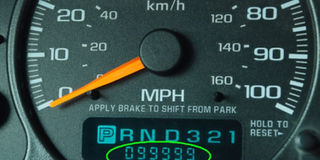Prime
How your car’s odometre works

What you need to know:
While most people only notice the displayed data, there is much more to the odometre. This article is all about understanding how odometres work.
Majority of road cars live a six-figure mileage life. It is only on rare occasions that you will find them dying out before hitting at least 200,000km, which is way more than 100,000, which, in turn, is the point of transition from five digits to six. As such, the manufacturers had to factor this in when building the instrument clusters of their products, giving an odometrewith a six-figure allowance.
So, given that the odometre has six slots, what happens between the moment the vehicle leaves the factory and the point it gets to 99,999km?
The vehicle will have its odometre reading 000000 while on the factory floor, then graduate to 000001 (1km mileage) as it starts moving around. It will get to 000010 (10km mileage), keep counting to 000100, and on to 001000, 010000 until 099999 (99,999km), at which point all those numerically useless but mechanically useful zero prefixes finally lose purpose and yield position to digits of real value as the vehicle mileage hits 100,000km (or miles, as may be the case for British and American market vehicles).

High mileage
Now, I had mentioned that most road cars live a six-figure mileage existence, meaning that they will reach the end of their productive lives anywhere between 100,000 and 999,999km (or miles), so they do not really need to count to a million. However, once in a while we get some extremely high mileage examples creeping out of the woodwork, cars that have exceeded a million kilometres of driving throughout their use. How do you express a million kilometres, which numerically occupies seven spaces, on a six-space cluster?
You do not. The odometre will go back to zero and start counting again from scratch, and by “go back to zero”, I mean it will show “000000”. The owner or driver knows it is at a million kilometres, so any figure displayed beyond this point will have an extra million kilometres appended to it to get the vehicle’s true mileage. This is how (and why):
The mechanical odometre is made of a series of interlocking circular drums connected either by tiny little cogs or pulleys or by a small peg that triggers the rotation of the adjacent drum. Each drum is divided into 10 segments, labeled serially from zero to nine, and each drum gives one slot on the odometre. While we have said that the cluster gives six-figure mileages only, there are actually seven drums and this is how they are connected:
Drums
On the extreme right we have drum one, which is almost always coloured differently from the other six, and on the extreme right we have drum seven, with drums two to six lying in between; think of the drum number layout as 7-6-5-4-3-2-1. Drum one, the right-hand off-colour drum is also divided into 10 segments, and indicates fractions of a kilometre. So, at complete zero mileage, the cluster will show seven zeroes, but the actual numerical figure is 000000.0 (take note of the decimal point).
Once the vehicle starts moving, drum one starts rotating as well. It will rotate according to the mileage covered from 0.1km all the way to 0.9km at which point it triggers (via peg or gear) the immediate adjacent drum (drum two) to the left to move up one click, from zero to one, as drum one rotates from nine back to zero.
As you keep driving, drum one keeps rotating through its fractions of a kilometre to trigger drum two through 1km of mileage all the way to 9km. After 9.9km, drum two triggers drum three to move from zero to one, while drum two goes back to zero. Drum one is still rotating, so the mileage will be 10.0km.
The rotations continue until 99.9km when drum three rotates back to zero trigger drum four to rotate from zero to one, at 100.0km; and so on and so on until all the drums reach the segment nine, which is at 999,999.99km. Another 0.1km and you will be at a million at which point all the drum segments rotate back to zero and the odometer shows 000000.0km.
In a nutshell
The drums start rotating from the extreme right. Ten rotations of drum one equal one rotation of drum two (0.1km x 10 = 1.0km). Ten rotations of drum two equal one rotation of drum three (1.0km X 10 = 10.0km), and so on and so forth all the way to ten rotations of drum six equaling one rotation of drum seven (10,000.0km x 10 = 100,000.0). Ten rotations of drum seven means a million kilometres (100,000.0km x 10 = 1,000,000.0 but there is no space for the leading digit - 1 - so only the zeroes are displayed).
Engine management system
Since the mileage is recorded electronically, you cannot just remove the odometer and plug it onto a grinder and start wheezing away, lopping off the miles; because the digital cluster is just a little screen like the one found on a pocket calculator. This makes it harder to tamper with, but not impossible.
Most of the electronic data in a car is stored somewhere centrally, either in a chip or within the engine management system (ECU) itself. Accessing the ECU used to be difficult, but is nowadays easily achievable via an OBD II diagnostic connection. While accessing the ECU is now possible, changing the details therein is not quite so easy; in some cases it is flat out impossible.





